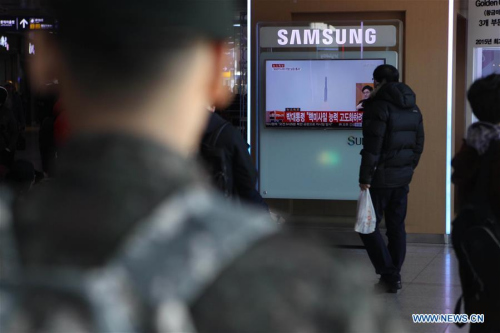
South Korean citizens watch a TV news program with a file footage about the Democratic People's Republic of Korea (DPRK) long-range missile launch, at Seoul Railway Station in Seoul, South Korea, Feb.7, 2016. (Photo: Xinhua/Seongbin Kang)
South Korea on Sunday announced the start of an official negotiation with the United States on possible deployment of an advanced U.S. missile defense system after the Democratic People's Republic of Korea (DPRK)'s nuclear test and long-range rocket launch in about a month.
The start of talks about deployment of Terminal High Altitude Area Defense (THAAD) to U.S. Forces Korea (USFK) came just hours after Pyongyang announced a successful launch of its Kwangmyongsong-4 Earth observation satellite into orbit in defiance of international warnings.
A rocket carrying the satellite is seen by Seoul and Washington as a long-range ballistic missile. UN Security Council resolutions ban the DPRK from testing a rocket by use of ballistic missile technology. On Jan. 6, Pyongyang tested what it claimed was its first H-bomb, the fourth of nuclear detonations.
Yoo Jeh-Seung, South Korea's deputy defense minister for policy, told a press briefing that Seoul and Washington had shared a view that the DPRK's recent nuclear test and long-range rocket launch show serious threats of weapons of mass destruction and ballistic missiles on peace and stability in South Korea and the entire Asia-Pacific region.
To respond to mounting DPRK threats, South Korea and the United States decided to kick off an official negotiation on the THAAD deployment to the U.S. Forces Korea to enhance a joint missile defense posture between the two allies, Yoo said.
The decision was made after USFK commander Curtis Scaparrotti requested it, Yoo said, noting that the official talks are aimed at jointly seeking possible THAAD deployment and its operational capability at an earliest possible date.
Repeated tests by the DPRK of its nuclear devices and long-range rockets are believed to have advanced its capability of miniaturizing a nuclear warhead small enough to fit on a long-range missile that can strike the U.S. mainland.
Pyongyang had conducted nuclear tests and long-range rocket launches almost simultaneously. About a month after the fourth nuclear test, the Kwangmyongsong rocket lifted off from the DPRK's main Tonchang-ri launch station on the west coast.
Two months before the third nuclear detonation, the DPRK launched a three-stage Unha-3 rocket into space for the purpose of what it claimed was to deliver a peaceful observation satellite.
To let negotiations go on, South Korea and the United States will form a joint working group that would first review an appropriate site for the THAAD deployment.
If the THAAD is deployed in northeastern coastal region of South Korea, it can intercept ballistic missiles launched from DPRK submarine, a South Korean defense ministry official was quoted by Yonhap news agency as saying.
The DPRK reportedly test-fired its submarine-launched ballistic missiles (SLBM) three times in 2015. The SLBM is seen by some as the most serious threat as a submarine-carried ballistic missile is much harder to detect in advance.
The THAAD is an advanced U.S. missile defense system designed to shoot down ballistic missiles at an altitude of 40-150 km. A THAAD battery is composed of six mobile launchers, 48 missiles and airborne radar and fire control system. The United States had expressed its willingness to deploy one or more batteries in South Korea.
One THAAD battery, valued at about 1.5 trillion won (1.3 billion U.S. dollars), is capable of covering as large as two thirds of South Korea, according to Seoul's defense ministry.
The South Korean military has no plan to directly purchase the U.S. missile defense system, and possible deployment will be made to U.S. troops stationed in South Korea, a legacy of the 1950-53 Korean War.
If deployed, Seoul would offer costs for the site and infrastructure, while Washington would cover costs for the deployment and maintenance.
If deployed, the THAAD will be operated against the DPRK alone, according to Seoul's defense ministry. The ministry believes that it can shoot down an estimated 2,000 DPRK ballistic missiles, including Scud, Rodong and Musudan.


















































